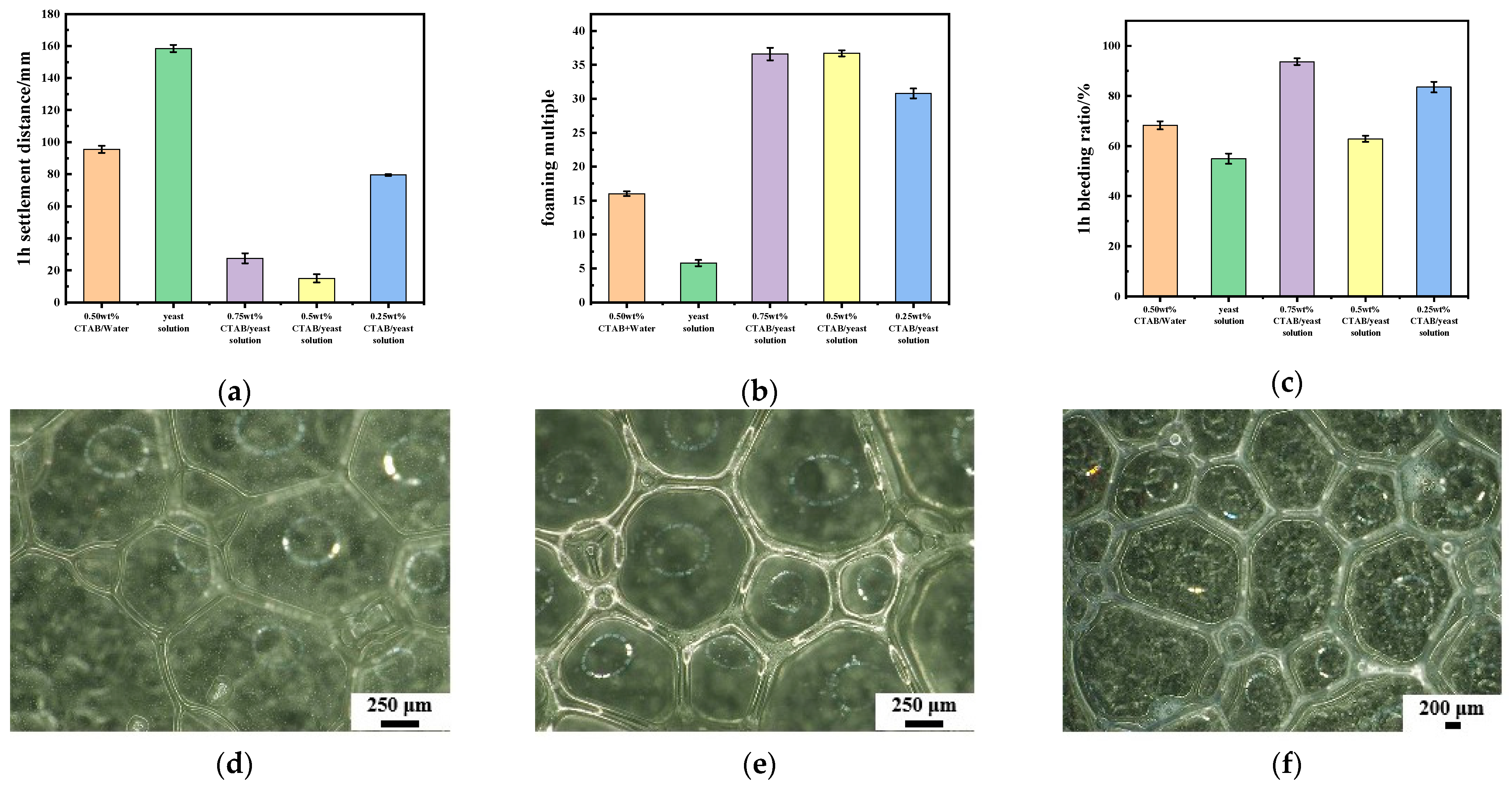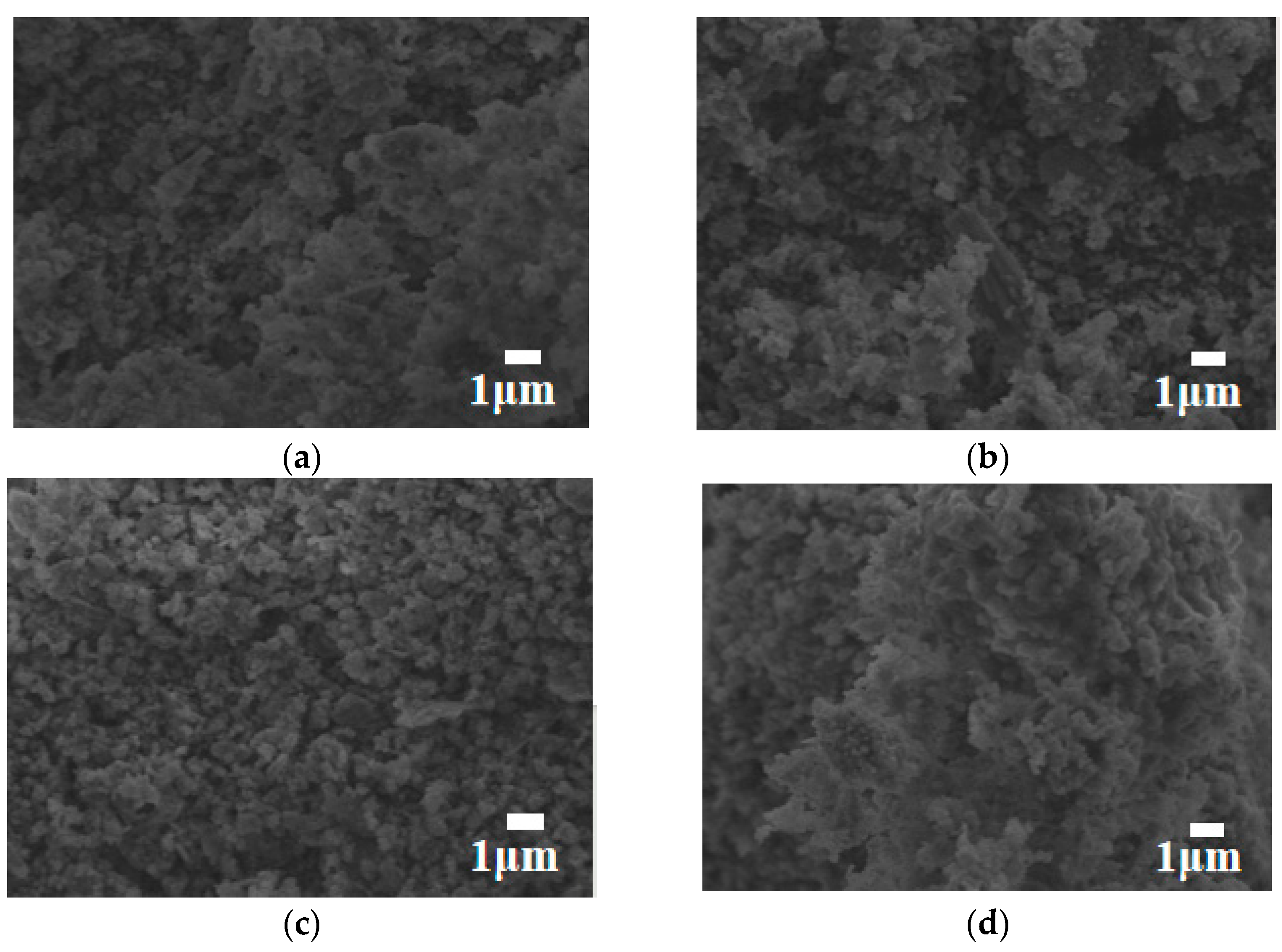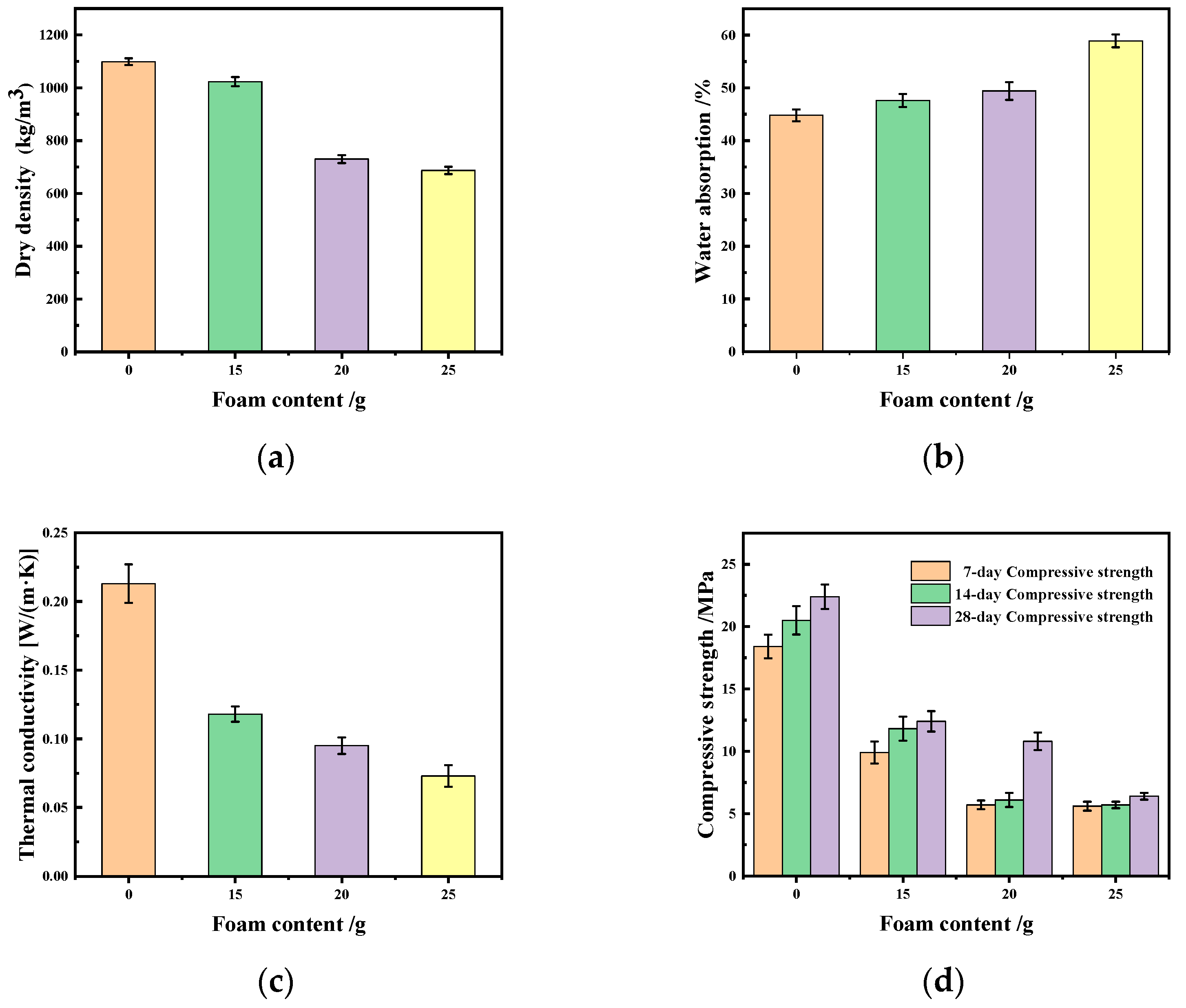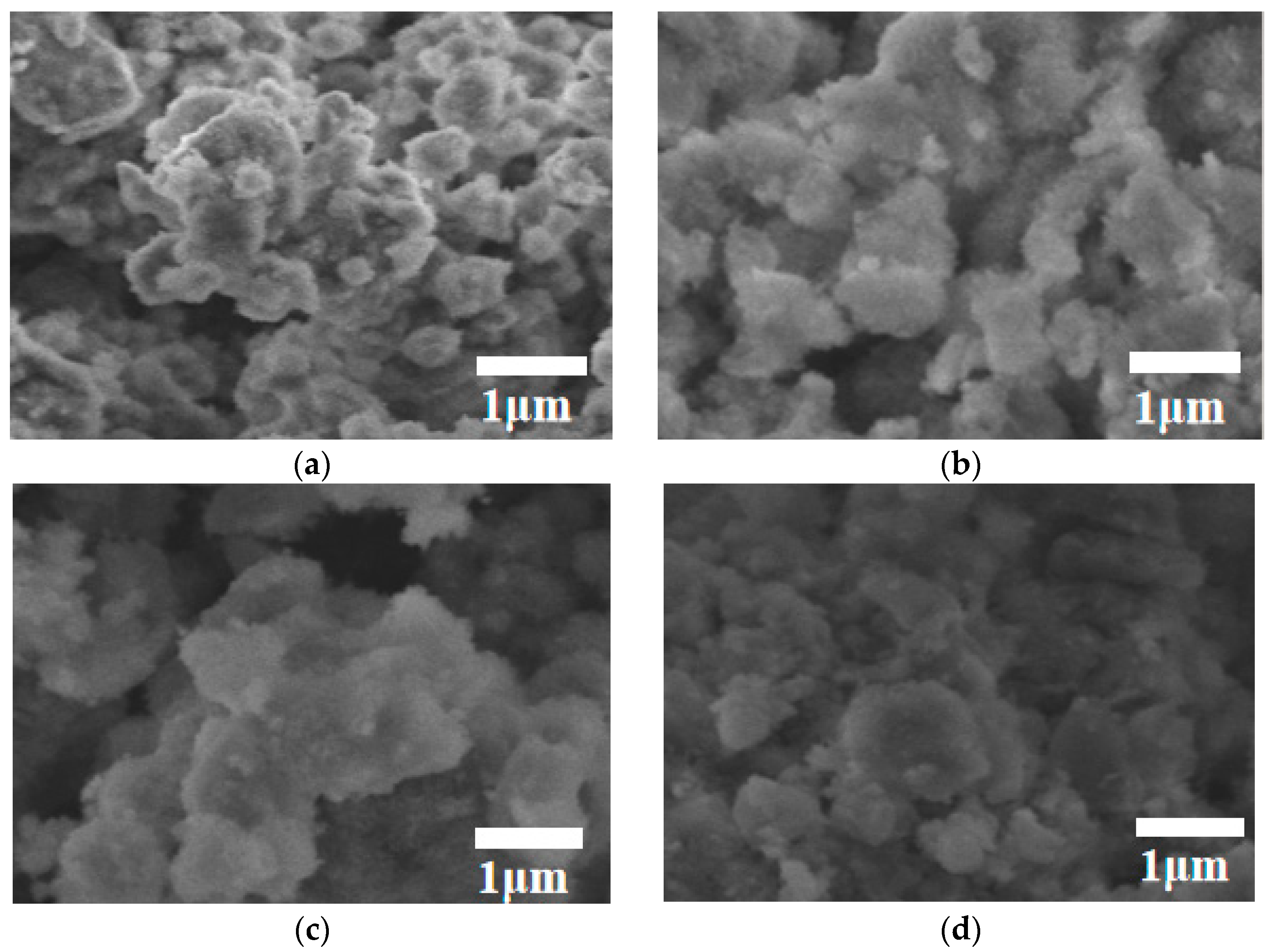Preparation and Properties of Lightweight Geopolymer by Bio-Based Foaming Agent
Abstract
1. Introduction
2. Experiments
2.1. Materials
2.2. Preparation of Lightweight Geopolymer by Bio-Based Foaming Agent
3. Results and Discussion
4. Conclusions
Author Contributions
Funding
Institutional Review Board Statement
Informed Consent Statement
Data Availability Statement
Conflicts of Interest
References
- Ślusarek, J.; Nowoświat, A.; Olechowska, M. Logistic Model of Phase Transformation of Hardening Concrete. Materials 2022, 15, 4403. [Google Scholar] [CrossRef] [PubMed]
- Gołaszewski, J.; Kostrzanowska-Siedlarz, A.; Cygan, G.; Drewniok, M. Mortar as a model to predict self-compacting concrete rheological properties as a function of time and temperature. Constr. Build. Mater. 2016, 124, 1100–1108. [Google Scholar] [CrossRef]
- Pu, S.; Zhu, Z.; Song, W.; Huo, W.; Zhang, C. A eco-friendly acid fly ash geopolymer with a higher strength. Constr. Build. Mater. 2022, 335, 127450. [Google Scholar] [CrossRef]
- Farias, T.; Bezerra, B.; Luz, A. Metakaolin-based geopolymer as an alternative binder in semi-insulating refractories. Mater. Lett. 2024, 354, 135321. [Google Scholar] [CrossRef]
- Hu, Y.; Tang, Z.; Li, W.; Li, Y.; Tam, V.W. Physical-mechanical properties of fly ash/GGBFS geopolymer composites with recycled aggregates. Constr. Build. Mater. 2019, 226, 139–151. [Google Scholar] [CrossRef]
- Walbrück, K.; Drewler, L.; Witzleben, S.; Stephan, D. Factors influencing thermal conductivity and compressive strength of natural fiber-reinforced geopolymer foams. Open Ceram. 2021, 5, 100065. [Google Scholar] [CrossRef]
- Vasić, M.V.; Jantunen, H.; Mijatović, N.; Nelo, M.; Velasco, P.M. Influence of coal ashes on fired clay brick quality: Random forest regression and artificial neural networks modeling. J. Clean. Prod. 2023, 407, 137153. [Google Scholar] [CrossRef]
- Billong, N.; Oti, J.; Kinuthia, J. Using silica fume based activator in sustainable geopolymer binder for building application. Constr. Build. Mater. 2021, 275, 122177. [Google Scholar] [CrossRef]
- Hamid, M.A.; Yaltay, N.; Türkmenoğlu, M. Properties of pumice-fly ash based geopolymer paste. Constr. Build. Mater. 2022, 316, 125665. [Google Scholar] [CrossRef]
- Huiskes, D.M.A.; Keulen, A.; Yu, Q.L.; Brouwers, H.J.H. Design and performance evaluation of ultra-lightweight geopolymer concrete. Mater. Des. 2015, 9, 167. [Google Scholar] [CrossRef]
- Shi, J.; Liu, Y.; Wang, E.; Wang, L.; Li, C.; Xu, H.; Zheng, X.; Yuan, Q. Physico-mechanical, thermal properties and durability of foamed geopolymer concrete containing cenospheres. Constr. Build. Mater. 2022, 325, 126841. [Google Scholar] [CrossRef]
- Jaya, N.A.; Yun-Ming, L.; Cheng-Yong, H.; Abdullah, M.M.A.B.; Hussin, K. Correlation between pore structure, compressive strength and thermal conductivity of porous metakaolin geopolymer. Constr. Build. Mater. 2020, 247, 118641. [Google Scholar] [CrossRef]
- El-Naggar, K.; Amin, S.; El-Sherbiny, S.; Abadir, M. Preparation of geopolymer insulating bricks from waste raw materials. Constr. Build. Mater. 2019, 222, 699–705. [Google Scholar] [CrossRef]
- Ducman, V.; Korat, L. Characterization of geopolymer fly-ash based foams obtained with the addition of Al powder or H2O2 as foaming agents. Mater. Charact. 2016, 1, 19. [Google Scholar] [CrossRef]
- Masi, G.; Rickard, W.D.; Vickers, L.; Bignozzi, M.C.; van Riessen, A. A comparison between different foaming methods for the synthesis of light weight geopolymers. Ceram. Int. 2014, 40, 13891–13902. [Google Scholar] [CrossRef]
- Novais, R.M.; Pullar, R.C.; Labrincha, J.A. Geopolymer foams: An overview of recent advancements. Prog. Mater. Sci. 2020, 109, 100621. [Google Scholar] [CrossRef]
- Ibrahim, W.M.W.; Ahmad, R.; Coman, B.T.; Abdullah, M.M.A.B.; Puskas, A.; Jaganathan, V.S. The effects of solid to liquid ratio on fly ash based lightweight geopolymer. Mater. Sci. Eng. 2020, 877, 012013. [Google Scholar] [CrossRef]
- Chen, Z.; Xu, G.; Cui, H.; Zhang, X.; Zhan, X. Preparation of hierarchical porous Al2TiO5-mullite ceramics by biological foaming and its microstructural characterization. Ceram. Int. 2019, 45, 8049–8053. [Google Scholar] [CrossRef]
- Zhang, M.; Wan, Y.; Wen, Y.; Li, C.; Kanwal, A. A novel Poly(vinyl alcohol)/carboxymethyl cellulose/yeast double degradable hydrogel with yeast foaming and double degradable property. Ecotoxicol. Environ. Saf. 2020, 187, 109765. [Google Scholar] [CrossRef]
- Menchavez, R.L.; Intong, L.-A.S. Red clay-based porous ceramic with pores created by yeast-based foaming technique. J. Mater. Sci. 2010, 45, 6511–6520. [Google Scholar] [CrossRef]
- Uhlířová, T.; Gregorová, E.; Pabst, W.; Nečina, V. Preparation of cellular alumina ceramics via biological foaming with yeast and its microstructural characterization via stereological relations. J. Eur. Ceram. Soc. 2015, 35, 187–196. [Google Scholar] [CrossRef]
- Su, L.; Fu, G.; Wang, Y.; Yao, G.; Zhang, J.; Xu, X.; Jia, B. Preparation and performance of a low-carbon foam material of fly-ash-based foamed geopolymer for the goaf filling. Materials 2020, 13, 841. [Google Scholar] [CrossRef] [PubMed]
- Su, Z.; Hou, W.; Sun, Z.; Lv, W. Study of in situ foamed fly ash geopolymer. Materials 2020, 13, 4059. [Google Scholar] [CrossRef] [PubMed]
- Sun, C.; Zhu, Y.; Guo, J.; Zhang, Y.; Sun, G. Effects of foaming agent type on the workability, drying shrinkage, frost resistance and pore distribution of foamed concrete. Constr. Build. Mater. 2018, 186, 833–839. [Google Scholar] [CrossRef]
- Hou, L.; Li, J.; Lu, Z.; Niu, Y.; Jiang, J.; Li, T. Effect of nanoparticles on foaming agent and the foamed concrete. Constr. Build. Mater. 2019, 227, 116698. [Google Scholar] [CrossRef]
- Xiong, Y.; Zhu, Y.; Chen, C.; Zhang, Y. Effect of nano-alumina modified foaming agents on properties of foamed concrete. Constr. Build. Mater. 2021, 267, 121045. [Google Scholar] [CrossRef]





| Metakaolin/g | Silica Fume/g | Fly Ash/g | Alkali Activator/g | Water-Reducing Agent/g | Water/g | Foam Content/g |
|---|---|---|---|---|---|---|
| 252 | 108 | --- | 140 | 2.5 | 220 | 0 |
| 252 | 108 | --- | 140 | 2.5 | 220 | 20 |
| 252 | 108 | --- | 140 | 2.5 | 220 | 25 |
| 252 | 108 | --- | 140 | 2.5 | 220 | 30 |
| 128 | --- | 282.5 | 111.5 | 2 | 200 | 0 |
| 128 | --- | 282.5 | 111.5 | 2 | 200 | 15 |
| 128 | --- | 282.5 | 111.5 | 2 | 200 | 20 |
| 128 | --- | 282.5 | 111.5 | 2 | 200 | 25 |
Disclaimer/Publisher’s Note: The statements, opinions and data contained in all publications are solely those of the individual author(s) and contributor(s) and not of MDPI and/or the editor(s). MDPI and/or the editor(s) disclaim responsibility for any injury to people or property resulting from any ideas, methods, instructions or products referred to in the content. |
© 2024 by the authors. Licensee MDPI, Basel, Switzerland. This article is an open access article distributed under the terms and conditions of the Creative Commons Attribution (CC BY) license (https://creativecommons.org/licenses/by/4.0/).
Share and Cite
Wang, T.; Chen, Y.; Jing, X.; Wang, X.; Zhang, L.; Yang, P. Preparation and Properties of Lightweight Geopolymer by Bio-Based Foaming Agent. Materials 2024, 17, 3167. https://doi.org/10.3390/ma17133167
Wang T, Chen Y, Jing X, Wang X, Zhang L, Yang P. Preparation and Properties of Lightweight Geopolymer by Bio-Based Foaming Agent. Materials. 2024; 17(13):3167. https://doi.org/10.3390/ma17133167
Chicago/Turabian StyleWang, Tianlei, Yao Chen, Xiudang Jing, Xueping Wang, Lei Zhang, and Peisen Yang. 2024. "Preparation and Properties of Lightweight Geopolymer by Bio-Based Foaming Agent" Materials 17, no. 13: 3167. https://doi.org/10.3390/ma17133167
APA StyleWang, T., Chen, Y., Jing, X., Wang, X., Zhang, L., & Yang, P. (2024). Preparation and Properties of Lightweight Geopolymer by Bio-Based Foaming Agent. Materials, 17(13), 3167. https://doi.org/10.3390/ma17133167





